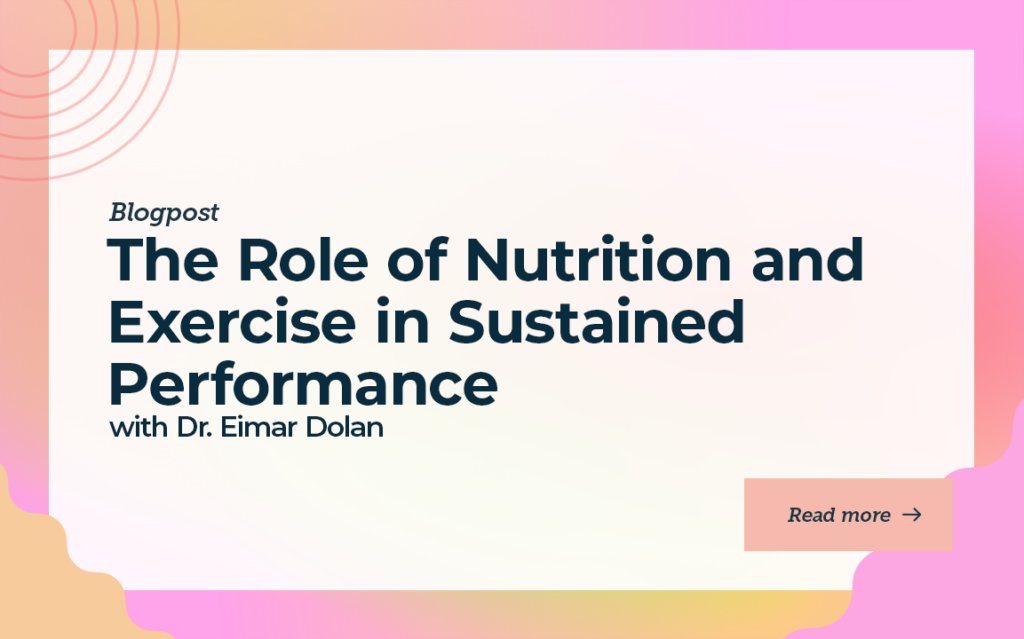The Role of Nutrition and Exercise in Sustained Performance

In this episode, Dr. Eimear Dolan, an exercise science researcher from the University of Sao Paulo, shares insights into energy regulation, particularly around fitness habits and weight management.
Dr. Dolan has focused much of her research on how we fuel exercise and how our energy intake significantly impacts performance, bone health, and even our approach to weight loss.
Rethinking Exercise for Better Health Outcomes
Dr. Dolan’s research provides new insights into exercise and energy use, challenging the classic view that physical activity always equals more calories burned.
Many assume that exercising more automatically leads to more calories burned and weight loss. But here’s the twist: your body has a built-in energy optimization system. Even if you ramp up your workouts, your body may compensate by saving energy elsewhere.
This constrained energy model concept means you won’t necessarily burn more calories just by working harder.
For those looking to get the most out of their fitness routines, consider how different activities impact overall energy use. Rather than increasing workout volume, focus on quality exercises that fit your body’s needs. This approach may help you stay consistent, avoid burnout, and better support your long-term health goals without constantly increasing your intensity or duration.
Pushing Your Body’s Limits and Fueling Strategically
Your body operates within certain energy limits regarding intense physical challenges like endurance events. While elite athletes can temporarily push themselves to extremes, the average person can typically sustain up to 2.5 times their basal metabolic rate (BMR) long-term without straining the body.
For short bursts, you can undoubtedly push beyond this, but it’s not sustainable for everyday fitness.
Understanding how your body processes carbs during intense exercise can also make a huge difference. Elite athletes, for example, often “train their gut” to tolerate and quickly absorb high levels of carbohydrates while performing. This means that through gradual adjustments, they can increase the amount of energy available during demanding activities, such as cycling or running long distances.
If you’re planning a big event or ramping up your workout, consider these tips:
- Fuel Incrementally: Introduce simple carbohydrates, like energy gels, during training to gradually train your body to absorb these nutrients efficiently. This way, you avoid gastrointestinal distress while maximizing energy availability during the event.
- Experiment During Training: Practice your fueling strategy well before race day. The best nutrition plans are personalized; what works for others might not suit your body. Find what carb sources and quantities work best for you.
- Stay Aware of Limits: Recognize that your body can only sustain a certain amount of calorie burn and absorption. Pushing too hard or fast can lead to burnout or injury, so balance high-intensity efforts with rest and recovery.
Whether you’re gearing up for a marathon or just trying to enhance your everyday workouts, fueling smartly and understanding your body’s limits are keys to sustainable progress and success.

Finding a Sustainable Approach
Accuracy is notoriously tricky when tracking calories for weight loss or performance. Tools like MyFitnessPal and smartwatches offer estimates but are often far from precise. Relying solely on these tools to calculate a calorie deficit might not yield the expected results.
Key Takeaways for Effective Calorie Management:
- Use Estimates as Rough Guidelines: Calorie-tracking apps can be helpful, but remember, they provide only rough guidelines. They don’t account for individual variations like metabolic rate or activity efficiency. Treat them as part of a broader strategy rather than the definitive answer.
- Adjust Based on Personal Experience: Since everyone’s metabolism and energy expenditure are unique, experiment and adjust your approach as you go. Notice how your body responds to different calorie intake levels and adjust according to your feelings rather than strictly following app recommendations.
- Consider Energy Burned During Exercise Carefully: Physical activity apps often overestimate the number of calories burned during workouts. The total calorie burn doesn’t just come from exercise. It also includes what you would have burned at rest. To account for this, avoid adding exercise calories directly to your BMR (basal metabolic rate) and adjust based on a sustainable, realistic increase.
- Factor in Compensatory Behaviors: If you push yourself hard during workouts, your body may naturally compensate by being less active later. Awareness of this tendency helps you avoid overcompensation, where you rest more than usual, reducing your overall calorie deficit.
- Track Food Intake with a Healthy Balance: Weighing food can be an eye-opener for understanding portion sizes and calorie content. However, tracking every calorie can become tedious or lead to burnout. Find a balance that gives you insight without becoming obsessive.
- Reframe Calorie Counting for Long-Term Success: If you find calorie counting frustrating or unsustainable, consider reframing it as part of a broader focus on health and fitness. Consider how it can help you make informed decisions rather than as a strict rulebook to follow indefinitely.
By viewing calorie tracking as a flexible tool rather than a strict science, you can develop a more intuitive approach to managing food intake and exercise.
Ultimately, the goal is to create a sustainable and enjoyable relationship with fitness and nutrition.
Rethinking Your Fitness Goals
Obsessing over the number on the scale can be counterproductive when pursuing fitness goals. Dr. Dolan suggests that it’s often more beneficial to focus on why you’re seeking a specific goal, such as improving overall health, enhancing performance, or achieving a desired appearance.
Weight alone isn’t a comprehensive measure of health or performance. While many assume losing weight is essential for peak physical fitness, other meaningful metrics can offer a better perspective on progress. For instance, the power-to-mass ratio, a concept commonly used in cycling, can be far more revealing. This ratio considers the power you generate and your body weight, providing insight into how effectively you move.
Prioritize Strength and Energy Over Weight
To lose weight, you might cut calories so severely that you sacrifice muscle, ultimately hindering your performance. Instead of solely focusing on reducing body mass, consider enhancing your strength and fueling your workouts effectively.
Proper nutrition enables your body to push harder and recover faster, improving overall fitness.
Key Takeaways
- Identify Your “Why”: Consider what you want to achieve before losing weight. Knowing your deeper motivations can guide you more effectively, whether keeping up with your kids, increasing endurance, or feeling more confident.
- Balance Weight and Performance Goals: If performance is your primary goal, focus on power and endurance rather than just weight. Losing muscle mass while cutting weight can diminish your ability to perform, especially in sports requiring power, like cycling.
- Shift Away from the Scale: Your energy levels, clothes fit, and ability to keep up with demanding physical activities can better gauge progress than the number on the scale. Even if the scale doesn’t move, improvements in these areas signify real progress.
For sustainable fitness, it’s essential to balance your approach. Remember, being in great shape isn’t always about weighing less. It’s about feeling stronger, healthier, and more capable of your body.
Quality Over Quantity
Instead of obsessively counting calories, focus on the quality of your food. You will naturally support your body’s needs by choosing nutrient-dense foods such as high-fiber vegetables and lean proteins.
Quality fuels like these provide lasting energy, help with muscle repair, and are less likely to lead to overeating.
Understand Your Body’s Fueling Needs
Athletes or those engaging in regular exercise may need more protein than the general population. Dr. Dolan suggests that an active person should aim for 1 to 1.2 grams of protein per kilogram of body weight to support muscle maintenance and growth. While high-level athletes might reach 1.5 or even 1.6 grams per kilogram, most people don’t need to get these extremes.
Avoid the Compensatory Behaviors Trap
Your body will adapt if you consistently train hard without adequate fuel. This can mean slower recovery, reduced endurance, and long-term impacts like bone loss or hormonal imbalances. Dr. Dolan recommends learning to recognize when to fuel up and not skimping on meals, especially post-workout, to prevent these compensatory behaviors.
In short, while apps and calorie counts can be helpful, they shouldn’t be the sole guide. By listening to your body, eating a balanced diet, and adequately fueling your workouts, you’ll likely feel stronger and more satisfied than if you were counting calories alone.

Why Smartwatch Estimates Fall Short
Smartwatches are built to provide quick, accessible data, but they layer estimation on top of estimation, mainly when calculating calories burned. This results in potentially significant margins of error.
For example, while a smartwatch might gauge calories based on heart rate and activity type, it doesn’t account for metabolic differences or body composition, which can significantly impact energy expenditure.
The Limits of Wearables for Calorie Tracking
Dr. Dolan explains that the gold standard for measuring energy expenditure is doubly labeled water, which is highly accurate but also complex and costly. Wearables, while convenient, simply don’t reach that level of precision, often miscalculating energy expenditure by a significant margin.
So, while they can be useful for tracking general trends, relying on them exclusively for calorie tracking can be misleading.
How to Use This Information
To get the most out of your smartwatch, use its data as a rough guideline, not a precise measure. Instead of relying solely on technology, pay attention to your body’s signals, such as energy levels, performance, and recovery.
If you’re looking for precise data, consulting a professional or participating in a study that uses advanced methods like doubly labeled water could provide a more accurate picture of your energy expenditure.
This is where understanding your body’s needs and using tools like smartwatches as supplemental guides rather than definitive trackers can help you make informed decisions about fueling and fitness.
Conclusion
Understanding how your body manages energy can be a game-changer for your fitness journey. Dr. Eimear Dolan emphasizes the importance of focusing on personalized fueling strategies and quality exercises over strict calorie counting.
Moving beyond numbers on a scale and instead considering factors like power-to-mass ratios and sustainable performance goals can create a healthier, more balanced approach to fitness.
Remember, it’s about making informed choices that support long-term well-being rather than relying solely on technology or rigid metrics.
For anyone looking to deepen their understanding of energy regulation and fitness, there’s no better time to start exploring personalized strategies prioritizing health, sustainability, and enjoyment.
Want to dive deeper into Dr. Dolan’s research? Explore her insights on exercise science here.
Looking to optimize your business performance with Predictable Revenue’s services? Learn how we can help you grow.
NO TIME TO READ?
Listen On:


